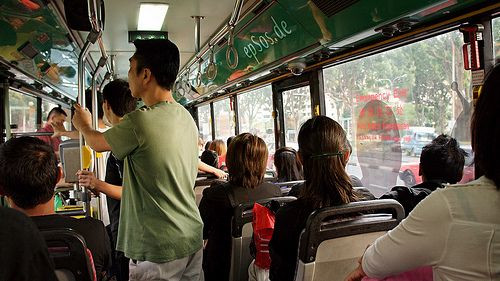Social Networks Between ‘Familiar Strangers’ Could Predict How Diseases Spread In Urban Areas

Consider the people you see at the gym after work, at the supermarket Sunday morning, in the elevator of your apartment building. You have no relationship to these people outside of seeing them on a regular basis, yet somehow you have a clear sense of their personalities, their backgrounds, their lifestyles. New data reveals these weak social ties are in fact sprawling, and they could have substantial implications for predicting the spread of disease.
These weak, but consistent social ties are what scientists often call "familiar strangers." They're the people who we interact with on a near-daily basis, yet with whom we have no intimate relationships. New research into the Singaporean bus system shows these social networks do a surprisingly good job of predicting the spread of disease in urban environments, as nearly every passenger on the bus was found to be somehow related to every other passenger.
"Usually when people study social networks, they mostly use questionnaires and interviews to analyze connections between family, friends or coworkers, but it's very difficult to ask questions about people they don't really know," said Juliette Stehlé, a physicist affiliated with the Research Center for Economics and Statistics in Paris. "In fact it's quite a black hole in the study of contacts."
Carried out by the Future Cities Laboratory in Singapore, the study on social networks included 20 million bus trips from 2.9 million passengers over the course of five days.
"It's the largest network analysis of daily encounters that has ever been performed," Scientific American reports, "and it reveals that interactions between strangers are not as random as some scientists had assumed."
The study uses anonymized data via "smart cards," which track where riders get on and off the bus. The researchers can assume a bird's-eye view to see how certain people interact with other familiar strangers on a daily basis in terms of their ride duration, destination, and frequency. They couldn't see if passengers spoke or communicated with one another.
As is probably expected, when two people encountered one another at the same time, it was usually in the morning on the same days. People who crossed paths tended to do so an average of 2.5 times per week. What's most surprising, however, is the sheer amount of networking that's taking place. Thousands of separate pairs aren't making connections with one another; rather, each pair has multiple other pairs whom they encounter.
"In the end, every Singaporian on the bus is linked to every other Singaporian on the bus," observed Kay Axhausen, a transport planner with the Federal Institute of Technology in Zurich and one of the authors on the new study. "Clearly they can't know all each other personally, but when you construct the networks for each person, all over these networks link up."
Constructing A Model For Diseases
A few years ago, two researchers at Stanford University developed a mathematical model to predict the spread of infectious diseases. They looked at Facebook data at first, using the community's network to create a "community bridge finder" algorithm.
"If there's a disease popping around a community with only one road out of town, then chances of it randomly making its way to another tightly knit community are pretty low," said co-author James Holland Jones, an assistant professor of anthropology. "The more roads there are out of town, the more likely it is that the disease will get out and spread. So the key is to find those roads and shut them down."
In urban areas, such as the Singapore bus system, nondiscriminatory viruses have a much easier time infecting people who see each other on a regular basis despite never interacting very meaningfully. It could very well be the case that a deadly strain of the flu came from the woman across from you on the bus or the man ahead of you in the checkout line; despite being closer to them, your relatives are not always to blame.
"If you know the structure of these networks," wrote Jones' co-author and biologist at Penn State University, Marcel Salathé, in an e-mail to Scientific American, "you can much better understand and predict how an epidemic is going to unfold, and who should be given priority with respect to intervention strategies."
The study of Singapore buses has intriguing applications going forward. Not only does Axhausen's team want to study other communities and environments of familiar strangers, but they want to examine how relationships and communities form based off of these environments.
Higher-level social interactions could have deep roots in evolution, adds Eric Paulos, founder of the field of urban computing and researcher at University of California at Berkeley. Perhaps familiar strangers develop relationships unconsciously, and perhaps the "familiar" part of the relationship is far more necessary than we typically assume.
"What if I went and removed all your familiar strangers from the city?" Paulos asked. "Your city would feel very different, because those people give you a sense of grounding and community even if you don't talk to them."
Published by Medicaldaily.com



























